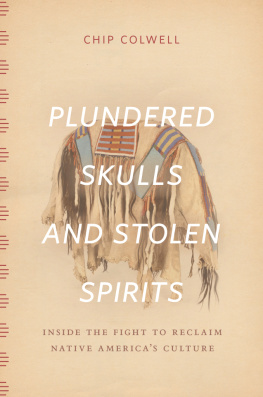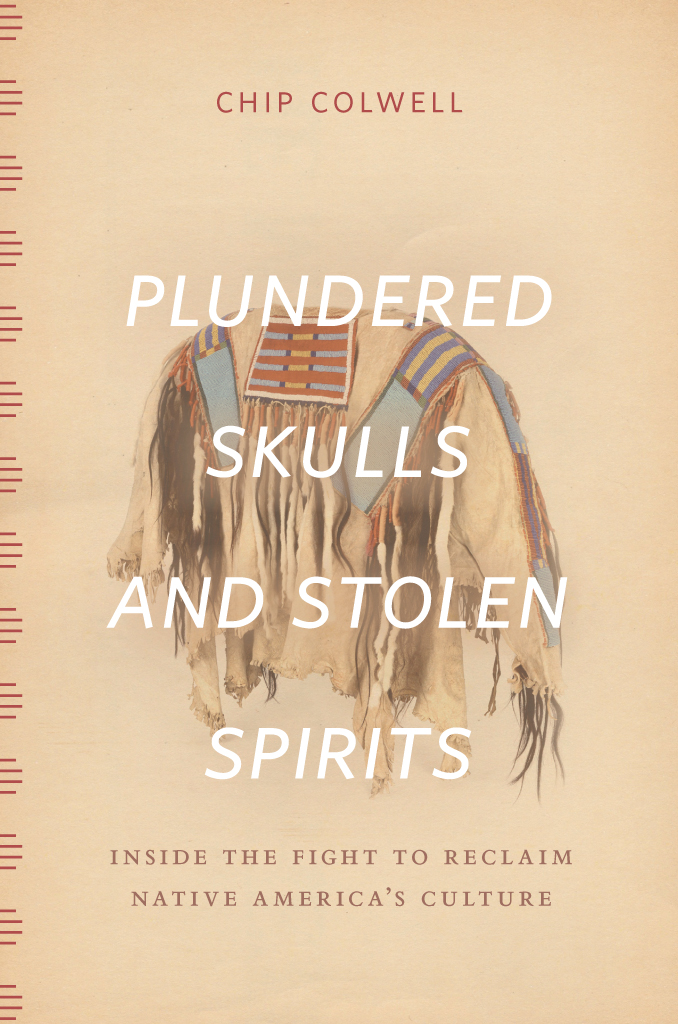All rights reserved. No part of this book may be used or reproduced in any manner whatsoever without written permission, except in the case of brief quotations in critical articles and reviews. For more information, contact the University of Chicago Press, 1427 E. 60th St., Chicago, IL 60637.
Published 2017.
Names: Colwell, Chip (John Stephen), 1975 author.
Title: Plundered skulls and stolen spirits: inside the fight to reclaim native Americas culture / Chip Colwell.
Description: Chicago; London: The University of Chicago Press, 2017. | Includes bibliographical references and index.
Identifiers: LCCN 2016036898| ISBN 9780226298993 (cloth: alk. paper) | ISBN 9780226299044 (e-book)
Subjects: LCSH : Indians of North AmericaUnited StatesAntiquities. | Indians of North AmericaMaterial cultureUnited States. | Human remains (Archaeology)RepatriationUnited States. | Cultural propertyRepatriationUnited States. | Museums and IndiansUnited States. | Anthropological museums and collectionsUnited States. | ArchaeologyMoral and ethical aspectsUnited States. | Anthropological ethicsUnited States. | United States. Native American Graves Protection and Repatriation Act.
Classification: LCC E 98. M 34 C 65 2017 | DDC 973.04/97dc23 LC record available at https://lccn.loc.gov/2016036898
An Ahayu:da shrine in 1898
Mary and Francis Crane, about 1950
Perry Tsadiasi exits the Laboratory of Anthropology in Santa Fe with a War God
Group portrait of the Camp Weld Council in 1864, with Black Kettle seated in middle row, third from left
George Cuneos display of Indian curios at his Denver home
Bench overlooking the Sand Creek Massacre reburial area
Chief Shakes VII wearing the Killer Whale Flotilla Robe
Interior of Whale House of Klukwan, Alaska, about 1895
The first repatriation ceremony at the Denver Museum, with Bob Pickering (far left), Mark Jacobs Jr. (wearing the Killer Whale Hat), and Harold Jacobs (far right)
Hugh N. Davis Jr., Hilda Curry Davis, and George B. Stevenson in an excavation pit at the Tallman Site
The plunder of our peoples graves has gone on too long. Let us rebury our dead and remove this shameful past from Americas future.
Suzan Shown Harjo (Cheyenne/Muskogee), American Indian activist
Were doing important work that benefits all mankind.... Were not going to return anything to anyone.
Frank Norwick, museum director
Past the moon rock, past the roaring Tyrannosaurus rex and the smokers black lungs, past the eight-pound nugget of crystallized gold and the Egyptian sarcophagus, past the Russian gem carvings and the grizzly bear diorama, and through an unmarked door is a room filled with the bones of Native Americans.
The narrow storage room at the Denver Museum of Nature & Science is lined with steel cabinets stuffed with Indian skulls and the skeletal fragments of legs and ribs and hands. Each bone is labeled like a library book with a tracking number, wrapped in coarse white muslin, and packed in a cardboard box. Long ago a staff member with a sense of irony hung a complete skeleton in the closet.
Many times Native visitors have come here to speak with the deadpraying to their ancestors through songs and drumming, filling the room with the silk curls of burning sweet grass, an offering to the spirits. But most days the room is silent and dark. The skeletons linger in a kind of purgatorywaiting for repatriation. Over the last twenty-five years, this room has slowly become vacant, the cabinets emptying shelf by shelf, like a cemetery in reverse. The bones have been going home.
Only two employees at the Denver Museum have keys to the room. I am one of them. This summer day, I enter the room to send twenty-six people back to their graves. After dozens of letters, calls, e-mails, and meetings with Native American religious and political leaders, the remains of these twenty-six people have finally been claimed by a consortium of tribes from across the Great Plains who wants them returned and reburied.
With two museum colleagues, I carry the bones from the storage room to a larger one nearby, concealed behind the Denver Museums exhibit on Native American cultures. Through the wall we hear the murmur of laughter and chatter. The crowd enjoying the exhibit suddenly makes me feel shifty. The visitors are clueless that just on the other side of the dioramas of wax Indians are dead Indians now lying in neat rows.
We begin unpacking them. The work proceeds methodically, purposefullysurgeons transplanting organs in the hushed gallery of an operating theater.
One coworker notes the museum tracking number for each set of human remains. Another hands me the bones. I wrap them in a traditional blanket, decorated with geometric shapes in hues of reds and blues, and soft as feather down. I tenderly lay the bundle of bones into a coffin of creamy unadorned pine, handmade by a local carpenter.
Most of the remains are fragmentary. Shattered ribs. Random fingers. Broken teeth. The single bone from a child, a clavicle, fits into a pine coffin the size of a sardine can. Some of the most damaged bones are packed into Ziploc bags. As I pour the fragments into the coffin, someone comments on the singularly sad sound that human bones make as they tumble out of a baga metallic ring, like a wind chime swinging in a gentle breeze. I tap the upturned bags, but static keeps the inside of the bags coated with fine bone powder mixed with dirt. I become distracted by the thought of these bags as a metaphor for repatriationhow hard it is to purge ourselves of the troubled past. The remnants of human lives cling stubbornly.
Three Native Americans stand by, scrutinizing the macabre task unfolding before them. After all of the pine coffins are filled, one of the white-haired elders steps forward. He is dressed like a cowboy but has the bearing of a high priest, full of quiet dignity. While chanting a muted prayer, he brushes the bones with a thick bundle of sage, which blesses them and broadcasts a soft scent of grass. He asks me to fasten the lids in place. He does not want to touch the bones. He has already put himself at awful risk. The ancestral spirits have been stirred. He could become very sick.
The elder says he is worried that we museum people, we non-Indians, have also endangered ourselves. I let him bless me with a fan of lustrous eagle feathers, which he grazes across my face and the outline of my body. I want to prove I respect this medicine man. But his beliefs are not mine. I do not fear bones. I am an anthropologist and a museum curator, trained to balance a curiosity about religion with sciences cold view that human remains are only devices for decoding history. For me, bones are no different from shards of pottery to be pieced back into beautiful vases.







 This paper meets the requirements of ANSI / NISO Z39.48-1992 (Permanence of Paper).
This paper meets the requirements of ANSI / NISO Z39.48-1992 (Permanence of Paper).